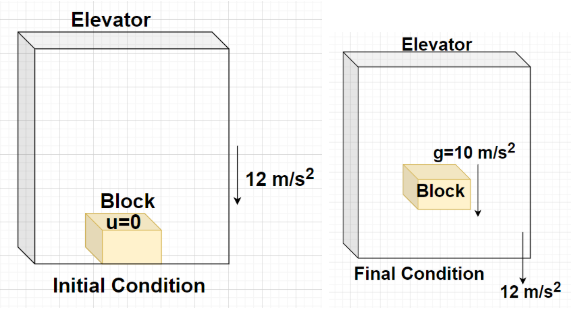
A block is kept on the floor of an elevator at rest. The elevator starts descending with an acceleration of 12 m/${{\text{s}}^2}$. Find the displacement of the block during the first 0.2 s after the start. (Take g = 10 m/${{\text{s}}^2}$)
${\text{A}}{\text{.}}$ 30 cm
${\text{B}}{\text{.}}$ Zero
${\text{C}}{\text{.}}$ 20 cm
${\text{D}}{\text{.}}$ 25 cm
Answer
597.6k+ views
Hint- Here, we will proceed by determining whether the block remains on the floor of the elevator or it detaches from it according to whether $a > g$ or $g > a$. Then, we will use the kinematic laws of motion in a straight line.
Complete step-by-step solution -

Formula Used- ${\text{s}} = {\text{ut}} + \dfrac{1}{2}{\text{a}}{{\text{t}}^2}$.
Given, Initial velocity of the block, u = 0 m/s
It is given that the elevator starts descending with an acceleration of 12 m/${{\text{s}}^2}$ which is greater than the acceleration due to gravity (i.e., g = 10 m/${{\text{s}}^2}$). So, the block which was initially kept on the floor of the elevator will no longer remain on the floor as shown in the figure. This means that the block will be experiencing a free-fall motion and will be moving in the downward direction with an acceleration equal to acceleration due to gravity (i.e., g = 10 m/${{\text{s}}^2}$).
According to Kinematic Laws of motion,
${\text{s}} = {\text{ut}} + \dfrac{1}{2}{\text{a}}{{\text{t}}^2}{\text{ }} \to {\text{(1)}}$ where s denotes the distance travelled by the body, u denotes the initial velocity of the body, t denotes the time taken by the body and a denotes the acceleration of the body.
Let us take the downward direction as a positive direction.
Here, u = 0 m/s, a = 10 m/${{\text{s}}^2}$ and t = 0.2 s
By putting the above values in equation (1), we get
Distance travelled by the block during the first 0.2 s after the start, ${\text{s}} = {\text{0}} \times {\text{0}}{\text{.2}} + \dfrac{1}{2}\left( {10} \right){\left( {0.2} \right)^2} = \left( 5 \right)\left( {0.04} \right) = 0.2{\text{ m}} = 0.2 \times 100{\text{ cm}} = 20{\text{ cm}}$
Therefore, the distance travelled by the block during the first 0.2 s after the start is 20 cm.
Hence, option C is correct.
Note- In this problem (where $a > g$), if instead of 12 m/${{\text{s}}^2}$ we are given with 9 m/${{\text{s}}^2}$ as the acceleration with which the elevator descends. Now we have $g > a$ case, so the block will remain on the floor of the elevator only. This means that the elevator and block descends with the same acceleration (i.e., 9 m/${{\text{s}}^2}$).
Complete step-by-step solution -

Formula Used- ${\text{s}} = {\text{ut}} + \dfrac{1}{2}{\text{a}}{{\text{t}}^2}$.
Given, Initial velocity of the block, u = 0 m/s
It is given that the elevator starts descending with an acceleration of 12 m/${{\text{s}}^2}$ which is greater than the acceleration due to gravity (i.e., g = 10 m/${{\text{s}}^2}$). So, the block which was initially kept on the floor of the elevator will no longer remain on the floor as shown in the figure. This means that the block will be experiencing a free-fall motion and will be moving in the downward direction with an acceleration equal to acceleration due to gravity (i.e., g = 10 m/${{\text{s}}^2}$).
According to Kinematic Laws of motion,
${\text{s}} = {\text{ut}} + \dfrac{1}{2}{\text{a}}{{\text{t}}^2}{\text{ }} \to {\text{(1)}}$ where s denotes the distance travelled by the body, u denotes the initial velocity of the body, t denotes the time taken by the body and a denotes the acceleration of the body.
Let us take the downward direction as a positive direction.
Here, u = 0 m/s, a = 10 m/${{\text{s}}^2}$ and t = 0.2 s
By putting the above values in equation (1), we get
Distance travelled by the block during the first 0.2 s after the start, ${\text{s}} = {\text{0}} \times {\text{0}}{\text{.2}} + \dfrac{1}{2}\left( {10} \right){\left( {0.2} \right)^2} = \left( 5 \right)\left( {0.04} \right) = 0.2{\text{ m}} = 0.2 \times 100{\text{ cm}} = 20{\text{ cm}}$
Therefore, the distance travelled by the block during the first 0.2 s after the start is 20 cm.
Hence, option C is correct.
Note- In this problem (where $a > g$), if instead of 12 m/${{\text{s}}^2}$ we are given with 9 m/${{\text{s}}^2}$ as the acceleration with which the elevator descends. Now we have $g > a$ case, so the block will remain on the floor of the elevator only. This means that the elevator and block descends with the same acceleration (i.e., 9 m/${{\text{s}}^2}$).
Recently Updated Pages
Why are manures considered better than fertilizers class 11 biology CBSE

Find the coordinates of the midpoint of the line segment class 11 maths CBSE

Distinguish between static friction limiting friction class 11 physics CBSE

The Chairman of the constituent Assembly was A Jawaharlal class 11 social science CBSE

The first National Commission on Labour NCL submitted class 11 social science CBSE

Number of all subshell of n + l 7 is A 4 B 5 C 6 D class 11 chemistry CBSE

Trending doubts
What is meant by exothermic and endothermic reactions class 11 chemistry CBSE

10 examples of friction in our daily life

One Metric ton is equal to kg A 10000 B 1000 C 100 class 11 physics CBSE

1 Quintal is equal to a 110 kg b 10 kg c 100kg d 1000 class 11 physics CBSE

Difference Between Prokaryotic Cells and Eukaryotic Cells

What are Quantum numbers Explain the quantum number class 11 chemistry CBSE




